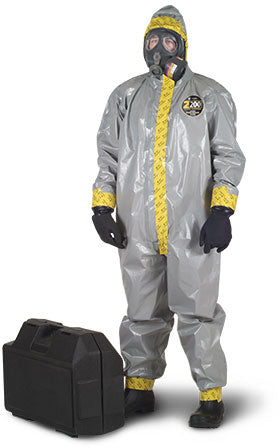Hazardous Material Suits and Chemical Protection Apparel
Hazardous material suits (hazmat suits) are an impermeable whole-body garment designed to prevent the wearer from coming into contact with hazardous materials. Hazmat suits are mostly used by firefighters, researchers, personnel responding to toxic spills, specialists cleaning up contaminated facilities and workers in toxic environments.
Hazardous material suits provide protection from:
- Chemical agents, through the use of appropriate barrier materials like teflon, heavy PVC or rubber and Tyvek
- Nuclear agents, possibly through radiation shielding in the lining, but more importantly by preventing direct contact with or inhalation of radioactive particles or gas
- Biological agents, through fully sealed systems — often at overpressure to prevent contamination even if the suit is damaged (positive pressure personnel suits) or using powered air purifying respirators with full hoods and protective suits to prevent exposure (level C protection level)
- Fire/high temperatures, usually by a combination of insulating and reflective materials which reduce the effects
Working in a hazmat suit is very strenuous, as haz-mat suits tend to be less flexible than conventional work garments, and hazmat suits can be hot and poorly ventilated (if at all). Therefore, use is usually limited to short durations of up to 2 hours, depending on the difficulty of the work. Level A suits, for example, are limited by their air supply to around 15–20 minutes of very strenuous work (such as EMS response or firefighting rescue in a building with known chemical hazards).
Hazmat protective clothing is classified as either Level A, B, C, or D, based upon the degree of protection they provide. Hazmat suits come in two variations: splash protection and gastight suits. As the name implies the splash protection suits are designed to prevent the wearer from coming into contact with a liquid. These hazmat suits do not protect against gasses or dust. Gas-tight suits protect the wearer from basically any outside influence the garment is rated for.
Level A Hazmat Suits
The highest level of protection against vapors, gases, mists, and particles is Level A, which consists of a fully encapsulating chemical entry suit with a full-facepiece self-contained breathing apparatus (SCBA) or a supplied air respirator (SAR) with an escape cylinder. A crew member must also wear boots with steel toes and shanks on the outside of the Level A chemical suit and specially selected chemical-resistant gloves for this level of chemical protection. The breathing apparatus is worn inside (encapsulated within) the suit. To qualify as Level A protection, an intrinsically safe two-way radio is also worn inside the suit, often incorporating voice-operated microphones and an earpiece speaker for monitoring the operations channel.
Level B Hazmat Suits
Level B protection requires a garment (including SCBA) that provides protection against chemical splashes from a hazardous chemical. Since the breathing apparatus is sometimes worn on the outside of the garment, Level B protection is not vapor-protective. Level B chemical suits can also be fully encapsulating, which helps prevent the SCBA from becoming contaminated. A level B hazmat suit is worn when vapor-protective clothing (Level A) is not required. Wrists, ankles, facepiece and hood, and waist are secured to prevent any entry of splashed liquid. Depending on the chemical being handled, specific types of boots and gloves, which may or may not be attached, are donned. The hazmat protective garment itself may be one piece or a two-piece hooded suit. Level B protection also requires the wearing of chemical-resistant boots with steel toes and shanks on the outside of the garment. As with Level A suits, chemical-resistant gloves and two-way radio communications are required.
Level C Chemical Protection
Level C protection differs from Level B in the area of equipment needed for respiratory protection. The same type of garment used for Level B protection is worn for Level C. Level C protection allows for the use of respiratory protection equipment other than SCBA. This respiratory protection includes any of the various types of air-purifying respirators. Workers should not use this level of protection unless the specific hazardous material is known and its concentration can be measured. Level C equipment does not offer the protection needed in an oxygen deficient atmosphere.
Level D Chemical Protection
Level D protection does not protect the crew member from chemical exposure. Therefore, level D protection can only be used in situations where a worker has no possibility of contact with chemicals. A pair of industrial work coveralls or other work-type garment along with chemical-resistant footwear with steel toes and shanks are all that is required to qualify as Level D protection. Most firefighter turnout gear is considered to be Level D.
- Previous page
- Page 2 of 2














